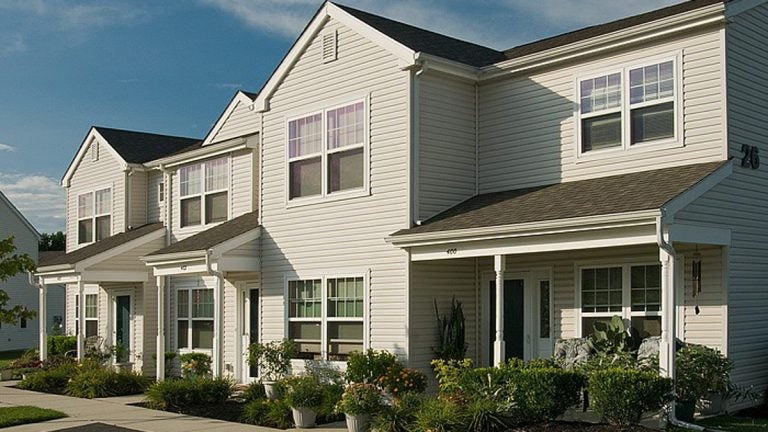Affordable housing advocates score victories in New Jersey

The Ethel R. Lawrence Homes was the first affordable housing complex built in the suburbs under the Mt. Laurel Doctrine. (Mark Lozier/Fair Share Housing Development)
In the decades-long battle to force more suburban New Jersey towns to make room for low-income residents, several recent developments are giving affordable housing advocates reason to smile.
Since July, housing advocates have won three major battles in the state: a legal settlement in Mt. Holly, the elimination of loopholes for suburban communities dragging their feet on building cheaper housing, and the publication of a Princeton University study that suggests that a suburbanite’s worst fears of having low-income neighbors were overblown.
Mt. Holly Settlement
The Obama administration got what it wanted when a New Jersey town opted to settle a housing discrimination lawsuit last month that was scheduled to be heard by the U.S. Supreme Court. The move prevents the nation’s high court, considered conservative leaning by the Administration, from striking a tactical blow to affordable housing advocates.
The lawsuit, Township of Mount Holly v. Mount Holly Gardens Citizens (pdf), alleged discrimination under the federal Fair Housing Act. In this case, the town planned to demolish a neighborhood, mostly occupied by blacks, and replace it with more upscale homes. But some of the homeowners said they wouldn’t be able to afford the new units and would effectively be kicked out of their own neighborhood. Obama administration feared the Supreme Court would strike down the plaintiff’s argument that discrimination can happen even if it is unintentional.
Mt. Holly’s council agreed to buy a number of the planned new homes and set them aside for low-income residents. The plan calls for 20 units for plaintiffs and require 24 homes that will sell below the market rate.
The last minute settlement has raised the issue of whether politics were involved. The day Mt. Holly approved the settlement, Republican Congressman Darrel Issa, who chairs the Committee on Oversight and Government Reform, formally requested documents from the developer hired to build the 44 special units.
Issa wants to know whether the developer, The Reinvestment Fund (TRF), got federal dollars, in part, to make it easier for Mt. Holly to settle.
Mt. Holly Twp.’s attorney, George Saponaro, explains that TRF is pursuing the usual (and legal) channels to obtain federal funding and adds that President Obama never contacted him. “To be clear there was never any involvement from the President or his Administration,” he said. “TRF is probably the best at what they do and it’s clear they’re not diverting any funds from other projects to this.”
The Mt. Laurel Doctrine
Affordable housing advocates scored a big victory in September. The New Jersey Supreme Court ruled that regulations written by the New Jersey Council on Affordable Housing (COAH) that permit municipalities to decide for themselves on how many affordable units are needed using future growth projections are unconstitutional.
This is not the first time the state’s high court has weighed in. The N.J. Supreme Court effectively wrote the state’s first suburban affordable housing laws and provided an unofficial national precedent when it ruled on Southern Burlington County NAACP v. Mt. Laurel Township in 1975 (Mount Laurel I). It later provided a clearer road map in its 1983 ruling (Mount Laurel II). The two decisions create what’s been called the Mt. Laurel Doctrine.
The Court’s latest decision gives COAH five months to adopt new rules to determine regional affordable housing plans.
The legal stalemate over the last decade, which is viewed by housing advocates as a way for suburban towns to keep lower-income homeowners and renters from moving in, prompted former COAH member Peter S. Reinhart to criticize in a recent newspaper editorial that, “The real losers were the thousands of lower-income people who could have been housed, but instead from 2004 to 2013 missed out on an economic boom period, a period of historically low interest rates.”
Fair Share Housing Center founder Peter J. O’Connor says that implementation of Mount Laurel III regulations by COAH, as ordered by the N.J. Supreme Court, could literally take COAH about a week to produce.
This exercise would produce figures for each of the state’s six regions and sub-allocate these figures to municipalities as their fair share housing obligations. But according to O’Connor, Gov. Christie won’t let COAH meet – a circumstance Fair Share Housing Center is now fighting in court. “We’re not talking about the Obamacare website. We’re talking about something pretty simple,” he said.
Over the past five years, New Jersey fair-housing supporter Sen. Ray Lesniak (D-Union) has gotten three bills passed that would have beaten the Supreme Court to the punch by revising the state’s Fair Housing Act and creating programs that would have turned foreclosed homes into affordable ones. Gov. Chris Christie vetoed all three. He’s also sought to abolish COAH and has called the Mt. Laurel Doctrine “an abomination.” “This is about getting Trenton the hell out of the business of telling people how many units they’re supposed to have,” he’s quoted as saying. “We need to lift that wet blanket off of the municipalities.”
Location, location, location
This summer a Princeton University study was published in book form that showed that having low-income families in the N.J. suburb of Mt. Laurel did not lead to rampant crime and plummeting property values.
“There was no difference between Mount Laurel and the neighboring townships,” Douglas Massey, the report’s author said. “There was no detectable affect at all on crime rates, property values and tax rates, even in the adjacent towns.”
Massey’s findings were published by Princeton University Press in Climbing Mount Laurel: The Struggle for Affordable Housing and Social Mobility in an American Suburb.
Conducting research over a three-year period, Princeton University sociology and public affairs professor Massey found that the Ethel Lawrence Homes – the first state-funded housing complex built in Mt. Laurel under the Doctrine – did not adversely impact the township and did positively benefit the complex’s residents.
Two-thirds of the Ethel Lawrence residents were employed compared with just half of people on the waiting list. The study also found that they earned an average of $19,687 a year, versus $12,912 for those on the waiting list. It also found that children in the homes attended “much higher quality” schools and studied six more hours per week.
“Being able to move out of their former neighborhoods into an affluent white suburb gave them higher rates of employment, earnings, and better mental health. They were less stressed and anxious, and their kids got access to much better schools,” said Massey.
On December 13th, PlanSmartNJ will present a policy briefing at The College of New Jersey in Ewing that opens with an overview of highlights from the book. Then two different panels will evaluate the latest Mt. Laurel court decision.
WHYY is your source for fact-based, in-depth journalism and information. As a nonprofit organization, we rely on financial support from readers like you. Please give today.




